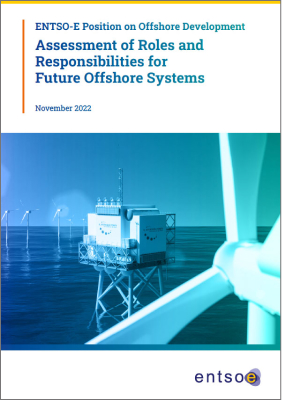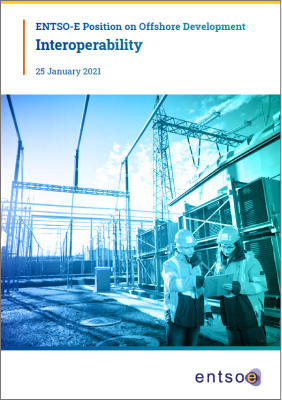European Resource
Adequacy AssessmentERAA
Offshore wind energy will bring a key contribution to reaching the objectives of the EU Green Deal. The EC’s offshore RES strategy anticipates the integration of 300GW offshore wind generation capacity into the energy system by 2050. The magnitude of this transition will raise new challenges for the European electricity system: accom-plishing the necessary connections and grid development at least cost; keeping the system secure; accommodating a complete redefinition of power flow patterns; considering key constraints linked to spatial planning, environmental protection, and public acceptance; achieving an integrated perspective over time, space and sectors; ensuring flexible resources to keep the power system balanced.
In a series of papers ENTSO-E assessed possible solutions to contribute to the realisation of the EC’s Offshore strategy:
Summary of Recommendations
In a series of papers ENTSO-E assessed possible solutions to contribute to the realization of the EC’s Offshore strategy. The following paragraphs summarize the key messages relating to the Offshore Strategy in the fields of system development, system operation, market design in which TSOs have an essential and active role in enabling the achievement of the EU offshore goals. A key finding is that existing roles and regulatory frameworks are largely fit for purpose also for networks being extended to marine environments. Existing, well-functioning solutions applied onshore can be used offshore as well; this is valid for system development, market design and system operations. Robust and well-established solutions can span both land and sea and will contribute to the success and fast delivery of the European offshore renewable strategy. Further quantitative analysis is also recommended to assess the final impact of the offshore development and the regulatory options considered on welfare, CO2 savings, market functioning, and on the way interconnected systems will be operated to maintain their security.

Download Assessment of Roles and Responsibilities for Future Offshore Systems
ENTSO-E has described and explored five different grid delivery models, based on different combinations of roles for system planning, asset design and construction, maintenance and ownership, and system operations. These model options are then assessed against a series of 13 criteria pertaining to efficient development and operation, project financing, and compliance with regulatory and legal frameworks.
Show
The paper finds that extending the Onshore TSO model to the offshore grid offers the most certainty for the development of the future offshore infrastructure to meet the 2030 and 2050 offshore renewables targets. This is supported by several criteria, from the ability to retain a holistic view on system planning on- and offshore, to the need for anticipatory investments. This model would also deliver on the integration of innovative solutions that can safeguard system reliability, multi-vendor interoperability requirements and reduce the overall impact on the environment. The existence of a fit-for-purpose regulatory approach with minor need for revisiting the legislation is also crucial for achieving the EU’s aim for a decarbonized electricity system. Some adjustments to this model may however be necessary to accelerate the pace of development and ensure TSOs are able to carry out the necessary investments at the required pace. On a case-by-case basis, coexistence with the competitive-light model could be considered to align with the pace of development of offshore renewables. Regarding the availability of equity, co-investor models with minority shares in certain projects or adequate incentives for identified offshore projects could be a solution. In general, and also valid for all delivery models, the pace of development of offshore projects needs to be accelerated and can be supported by a simplification of permitting processes and by working on means to increase public acceptance. Additional questions for further analysis revolve around cost-allocation between countries with both direct and indirect roles in developing offshore hybrid projects and offshore infrastructure in general, as already initiated via the revised TEN-E regulation. Other discussion points outline the need for a better coordination of national offshore regulatory frameworks at all levels.
Download Assessing Selected Financial Support Options for Renewable Generation
To ensure that new offshore wind farms connected to offshore hybrid projects can be rapidly deployed, additional financial support may be needed in some cases to provide sufficient profitability and a stable investment outlook. This is likely to be even more so when considering the application of Advanced Hybrid Coupling under which wind farm market revenues will become more volatile than under the classical rules of the Available Transfer Capacity model.
Show
While some proposals have emerged, suggesting a possible re-allocation of a share of the congestion income from TSOs to wind farm developers as a possible source of support, such an approach would face several challenges. First, it is based on the assumption that an offshore hybrid project implies a redistribution effect between generation and transmission under the Offshore Bidding Zone setup. This is however not that straightforward under Advanced Hybrid coupling, which will be applied in the Core and Nordics Capacity Calculating Regions (in compliance with Flow-based market coupling) by the time the next offshore hybrid projects are commissioned. In fact, with the application of Advanced Hybrid Coupling, both wind farm revenues and congestion income will both become more volatile and decorrelated from one another. Furthermore, any reallocation of congestion income to offshore wind farms would subsequently affect the tariffs paid by the onshore users of the grid, since the level of tariffs will increase by an amount equal to the share of CI used to cover OWF developer costs. This poses an important risk to the ability of both the market and the tariff regime give the right economic price signals. Based on an assessment of the main options currently discussed (namely ex-post reallocation via amending Article 19 of Regulation 2019/943 or ex-ante reallocation via FTRs), it appears that no approach proposed thus far under which congestion income would be reallocated to offshore wind farms seems to provide adequate support to generators while also safeguarding against possible market distortions, cross-subsidisation and other policy risks. The focus should instead be on enhancing existing state-funded support schemes, awarded via competitive processes, for the purpose of cross-border renewables.
Download System Operation & Governance
ENTSO-E trusts that addressing system operation challenges arising from large scale offshore energy integration can be tackled by building on existing solutions, especially by utilizing all possible means to keep the system balanced and through enhancing TSOs’ direct coordination, with Regional Coordinating Centers (RCCs), and including non-EU neighbors.
Show
The current regulatory setup is suitable to cope with the expected stepwise development of offshore grid infrastructure. Existing roles of TSOs and RCCs can be applied offshore, ensuring efficient offshore RES integration, safe system operations and sharing of reserves across the entire European energy system. Moreover, and given the scale of the expected transition, stability in the regulatory design for system operation is essential to ensure reliable and secure operation, which TSOs provide in the interest of society. The focus should be on full implementation of the existing legislation and improving existing solutions, aimed particularly at increasing the efficiency of market and system operations. The challenges ahead are huge and not all answers are known today as technology will evolve. However, parallel development of flexibility and innovative solutions, for example large-scale storage, is a precondition for the successful offshore renewable energy integration. TSOs are ready to continue taking strong responsibility for the efficient and coordinated development and operation of the grid infrastructure, both onshore and offshore and engage with all actors for the successful realization of the Internal Energy Market (IEM) and the achievement of climate neutrality targets.
Download Interoperability
Multi-terminal and multi-vendor interoperability will be essential for ensuring successful development of the HVDC offshore systems, contributing to increased cost efficiency and reliability of the future grid.
Show
Technical interoperability and standardisation needs to consider future technological developments. TSOs will continue to contribute to the R&D efforts aiming at development of practical technical and legal solutions in collaboration with technology providers, relevant stakeholders and policy makers. To support the development of the interoperability requirements, a real full-scale demonstration project is deemed necessary to reach higher level of technology readiness and facilitate the standardization of systems and equipment in a “plug and play” way.
Download Market and Regulatory Issues
While single-purpose solutions are well-established in the existing market framework, the deployment of dual and multi-purpose solutions needs to consider how offshore wind power should be treated marketwise. After consideration of the pros and cons of the two main market design concepts and subject to further quantitative analysis, the use of Offshore Bidding Zones (OBZ) appears to be a promising solution.
Show
Indeed, it ensures market and system operation efficiency through competition, reflects physical limitations of the grid, gives correct price signals to other purposes including on site hydrogen production and is compatible with existing requirements for capacity allocation as well as with Flow-Based market coupling principles (Advanced Hybrid Coupling). The OBZ market design could, however, have an impact on market revenues for Offshore Wind Farms connected to a hybrid asset, in comparison with the home market model. While the actual effect on final positions would significantly vary from one project to the next, a revenue stabilization mechanism for the wind farm operators might be needed. The choice of an appropriate mechanism in that respect and especially the source of financing needs to be assessed against possible effects on market functioning and competition, the impact on onshore grid users, and compatibility with key principles underlying tariff setting rules in the EU. Solutions with respect to RES remuneration should be compatible with the principles of onshore market and grid operation.
Download ENTSO-E Position on Offshore Development
Currently, offshore grid developments consist mainly of single-purpose solutions, such as radial connections of offshore windfarms (OWFs) and submarine interconnections connecting two bidding zones. In the future, these single-purpose solutions will continue to be chosen in many cases, but additionally there will be an increasing number of dual-purpose solutions that connect both markets and wind to shore (‘offshore hybrids’). Multi-purpose solutions, which additionally could cross energy sectors and include offshore consumption (e.g. electrolyzers), will emerge as well.
Show
To cope with these developments, ENTSO-E and the TSOs will expand their planning support tool – the Ten-Year Network Development Plan (TYNDP) – to integrate offshore and onshore developments, ensuring holistic planning across time, space and sectors (a one-system approach) to bring offshore renewable energy to end-users. TSOs are responsible for selecting the most appropriate connection point to shore, considering potential onshore congestions, expected future generators’ connections, and necessary network development or reinforcements. TSOs are strongly committed to ensure the future offshore grid is developed and operated with full respect for the maritime environment and other activities taking place in the maritime space.
Download
 ENTSO-E
ENTSO-E